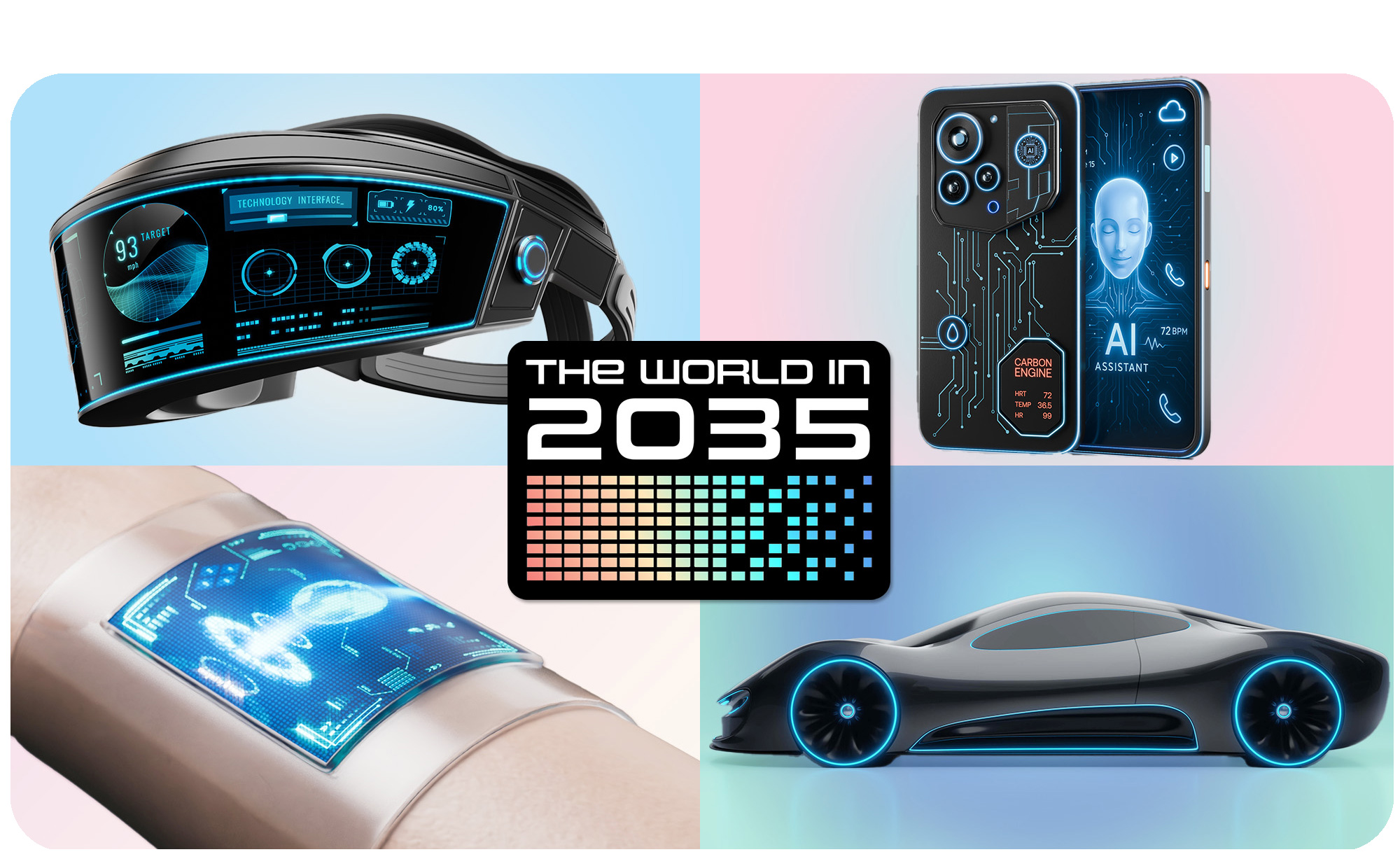The future of wearable wellness tech: 5 wild predictions for 2035 according to experts and industry leaders
Batteries that stay charged forever, contact lenses that remember names and health sensors on everything imaginable, from your steering wheel to your underpants
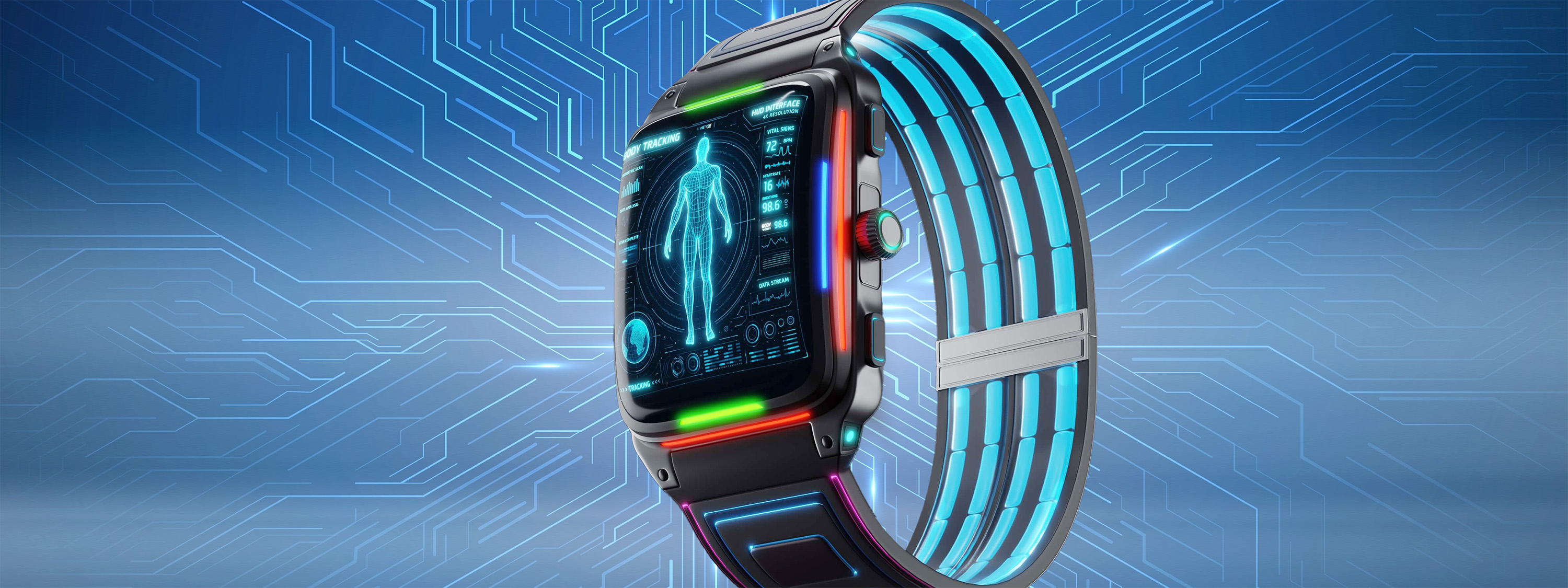
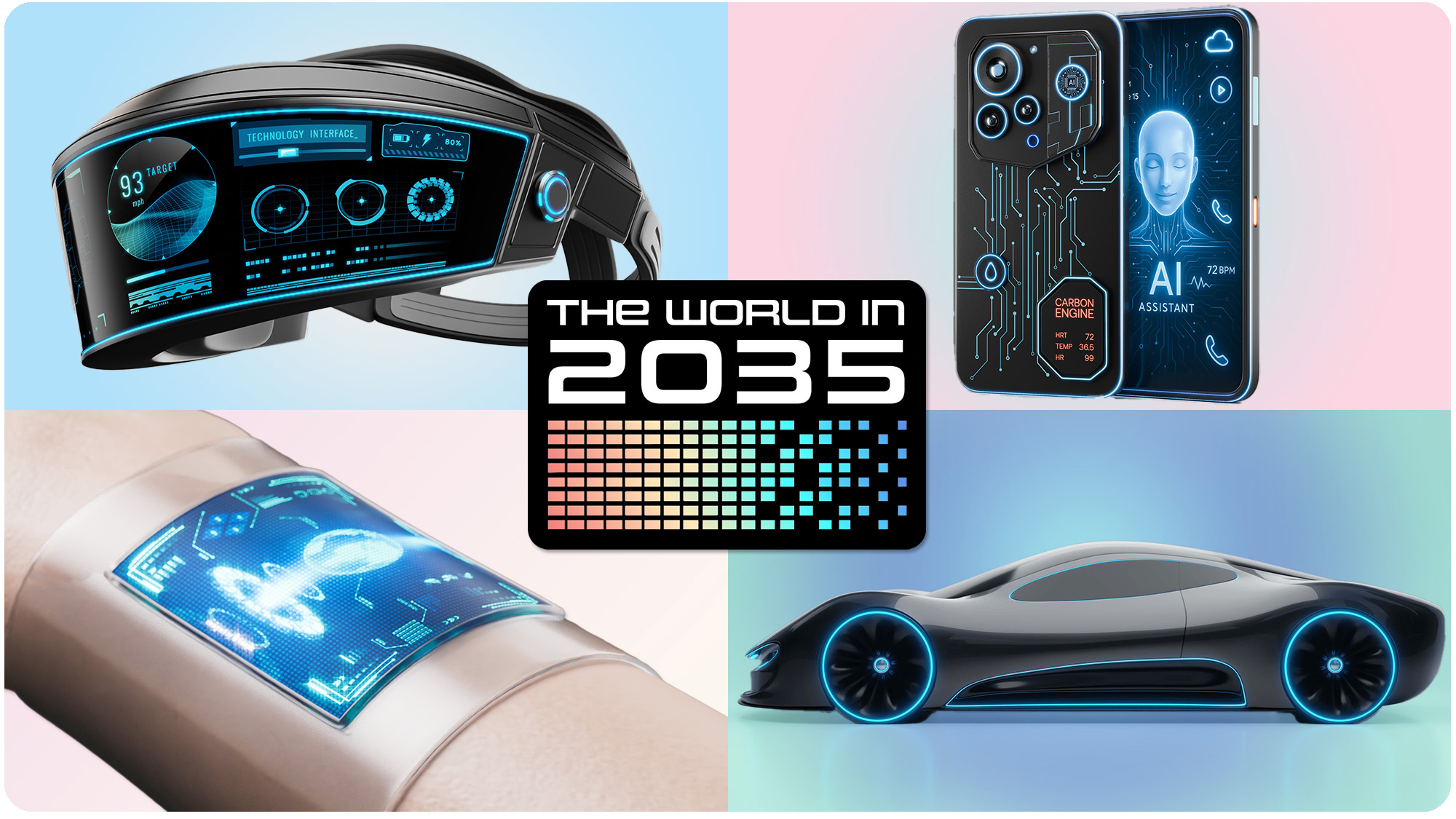
AI | Smart Glasses | Wearable Tech
Smartphones | iPhones | Robots | Cars | TVs
In 2035, your Apple Watch Series 36 could arrive with enough battery power to last the lifetime of the wearable; I’m talking years rather than days, i.e., no recharging required.
Don’t like wearing a watch? All those holistic sensors may come in an assortment of new forms, including flexible and near-invisible stick-on ‘smart patches’ that look kind of like a Band-Aid but stay put for weeks or even months.
As the speed in which health data can be processed and analysed continues to improve, while physical holistic sensors get tinier and tinier, keeping tabs on your vitals ten years from now will likely not be handled by one piece of dedicated wearable tech, but by an array of health-sensing devices you don’t even have to think about, like the steering wheel of your car if you commute by automobile, your contact lenses (even if you don’t require corrective vision), or even the waistband of your favorite underpants.
With so much information to decipher, AI will be the backbone that powers future wearable wellness technology. The promise of early detection of not just chronic disease but everyday illness will be another crucial selling point of tomorrow’s wearable devices, and the best devices will offer sensible, actionable steps to follow if something does come up.
To get a clearer picture of our possible wearable/embeddable future, I spoke with an array of experts and industry leaders in the field, including, Angela McIntyre, the director of the Stanford’s Wearable Electronics Initiative; Amaury Kosman, the founder and CEO of the smart ring brand, Circular; Jason Russell, the vice president of software at Oura Ring; Antoine Joussain, a lead product manager at the consumer health technology brand, Withings; Roman Axelrod and Dr Valentyn Volkov, cofounders of the smart contact lens startup Xpanceo; and Michael Hayes, the CEO of the smart contact startup InWith Corp.
These conversations resulted in five major trends surrounding wearables and embeddables for the year 2035: More form factors, batteries that last the life of the device, predictive monitoring for both chronic diseases and everyday conditions, AI connecting the dots between wellness metrics and healthcare, and further incorporation of smart features that make life easier/less stressful.

The end of rechargeable batteries
Battery life, or lack thereof, is one of the biggest factors holding back today’s wearables. Relatively reliable subscription-free wearables can be picked up for $100 or less (see the Amazfit Active 2), but few last longer than a week on a single charge. Fortunately, in 2035, the need to plug in may be as antiquated as the away message.
“Our goal is for [the battery] to last the lifetime of the device,” says Antoine Joussain, a lead product manager at the French wellness tech brand, Withings. “So if a device is lasting for five years, we’d like [the battery] to last for five years too.”
This will come through both innovations in battery technology and reductions in power consumption.
Nearly everyone I spoke to for this article mentioned flexible or even stretchable batteries. Such technology would be crucial for developing a truly band-aid-style "smart patch," notes Angela McIntyre, the Executive Director of Stanford University’s Wearable Electronics Initiative (eWEAR). More on that below.
Some wearables brands like the smart ring manufacturer, Circular, already use bendable batteries in their product design. However, at the rate at which battery technology is currently developing, the batteries of 2035 will likely look vastly different than today’s.
“We already have flexible batteries in our rings, and we're trying to max them out. Over the past six years, I've seen three different technologies used in batteries, so different materials that can withstand more and more capacity,” says Amaury Kosman, the Founder and CEO of Circular.
“By 2035, it’s plausible that wearables could integrate hybrid energy systems that passively recharge throughout the day, vastly extending runtime and reducing dependency on charging cycles.”
— Jason Russell, VP of Consumer Software, Oura
Power management improvements won’t only come in the form of better batteries. “More efficient signal paths and the ability to disable unused sensors will also contribute meaningfully [to improved battery life]” says Jason Russell, Oura’s VP of consumer software, when asked what a theoretical Oura Ring 10 might look like.
Another hot topic: energy harvesting. While ten years is likely too soon for our smartwatches to be powered solely by body heat, McIntyre reports that researchers at Stanford and elsewhere are hard at work making the concept a reality.

“Motion of a person could be harvested as well,” says McIntyre.
Of course, self-charging wearables do exist in 2025. The Garmin Instinct 3 Solar, which features a light-sensative cell behind the device’s screen, is a great example. However, by 2035, solar charging capabilities might be small enough to fit directly into a contact lens.
“We are developing light-harvesting features integrated into the lens surface, allowing ambient sunlight or indoor lighting to contribute to the power supply. While energy harvested this way is modest, the low power demands of contact lenses make even small boosts valuable," says Dr Valentyn Volkov, the cofounder of Xpanceo.
While the founder of the Circular Ring, Amaury Kosman, seemed skeptical of wearables' self-generating energy by 2035, Oura’s VP of Consumer Software, Jason Russell, sounds more optimistic.
“By 2035, it’s plausible that wearables could integrate hybrid energy systems that passively recharge throughout the day, vastly extending runtime and reducing dependency on charging cycles,” says Russell.

Health monitoring sensors … everywhere
Don’t expect watches or rings to disappear anytime soon, because whether smart or not, this style of jewelry is likely here to stay. On the flip side, do expect the sensors you already see in smart rings and smartwatches to eventually appear in other wearable products, like earbuds, bracelets, stick-on patches, contact lenses and smart clothing.
“The idea is to make it disappear,” says Joussain when asked what the future of health-sensing technology looks like for Withings. That’s a pretty bold statement for a brand that makes a somewhat chunky metal smartwatch with considerable heft in 2025.
Ultimately, ten years from now, holistic sensors will be small enough to be installed just about anywhere, not just in wearables but also your computer mouse and even your car’s steering wheel. Essentially, wherever you’re most likely to interact with them.
“All these new [health tracking] technologies will be implemented in everyday objects. So, you take your car every day, when you are holding the steering wheel, it will monitor your vitals,” predicts Joussain.
Ultimately, Joussain suspects that health sensors will be embedded directly into the user's body. However, he confesses that the concept is almost certainly more than a decade off. Stanford’s McIntyre agrees. Instead, she thinks stick-on smart patches packed with holistic sensors are more likely to make an impact in the next ten years.
“There are new sensors that are coming, and with your flexible, stretchable capabilities, they'll be even more that we can do from a sticky patch,” says McIntyre.
“All these new [health tracking] technologies will be implemented in everyday objects. So, you take your car every day, when you are holding the steering wheel, it will monitor your vitals”
— Antoine Joussain, lead product manager, Withings
Much to my surprise, Circular’s founder, Amaury Kosman, also thinks that smart patches could be the way of the future when it comes to at-home health monitoring.
“A patch, which is tiny and anybody can wear, I think that's the future of where we're heading. As time goes by, everything gets miniaturized, everything gets more precise, and it gets cheaper. So it's just a logical next step for me,” says Kosman when asked what future wearables will most likely look like.
Similarly, Oura's Jason Russell acknowledges that the future of wellness monitoring might go beyond the singular smart ring. "We foresee stretching the boundaries of biometric sensing via the ring while integrating complementary wearables that together enable an even more complete picture of your health," Russell says.
Outside of smart patches, what other new wearable health-monitoring tech can we expect to take off in the next decade?
“Smart contact lenses, being in direct contact with the eye's surface and tear film, function as a tiny biochemical laboratory on the eye. This close proximity enables continuous, noninvasive monitoring of a variety of health metrics,” says Dr. Volkov.

Early detection and treatment for chronic diseases and everyday ailments
The best smartwatches already alert users to potential signs of chronic health issues. Popular models like the Apple Watch 10 and Samsung Galaxy Watch 8 monitor for signs of sleep apnea and heart abnormalities, like AFib. The Google Pixel Watch 3 can even trigger an alert and send for help if a loss of pulse is detected.
However, these tools are just scratching the surface. In ten years, your smart wearable may be able to screen for a whole range of chronic conditions, like diabetes, cancer or heart disease. These devices may also be able to give you a 72-hour heads-up to an upcoming cold, or alert you to heightened biomarkers that could indicate elevated stress, with actionable advice to return to your baseline.
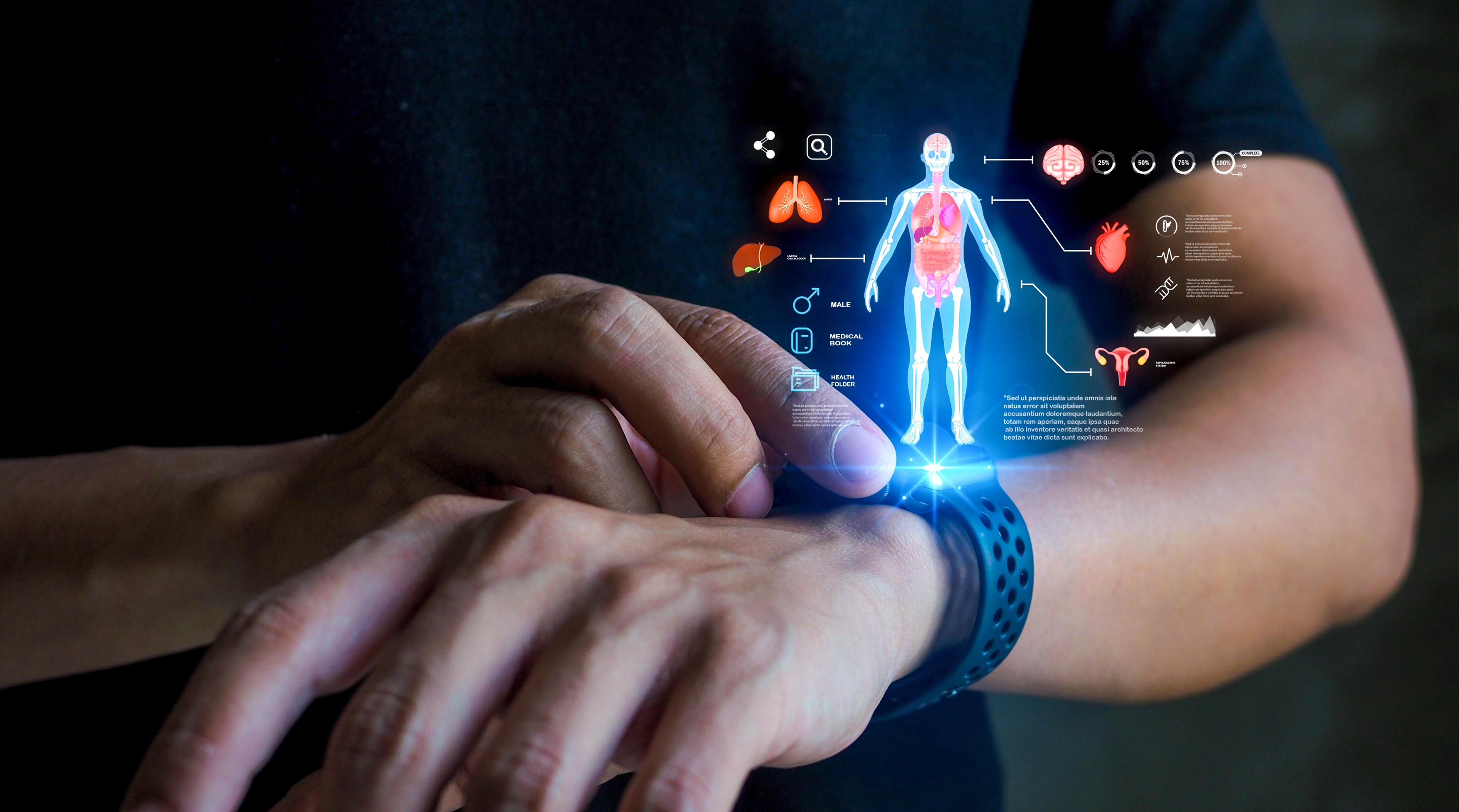
“As sensors become more advanced and miniaturized, the depth and granularity of data will also increase significantly. But the biggest shift will be in how insights are delivered: instead of just showing you the data, future insights could anticipate changes in your health, offer personalized, real-time guidance, and adapt to your unique physiology and goals—making the experience more predictive, proactive, and deeply personalized than ever before,” says Oura’s Jason Russell.
Ultimately, the future of disease detection may rely less on developing new sensor technology and more on making the most of the data already coming off the sensors we currently have. Enter, the promise of AI.
“AI is getting a lot better, being able to discern what's a ‘real’ signal out of very noisy data, and then being able to make insights that are more valid for us from that data,” says McIntyre.
The use of artificial intelligence to analyze health data, effectively replacing manually written code, will exponentially increase the ability for software to sniff out health trends and make personalized recommendations, notes McIntyre.
“As sensors become more advanced and miniaturized, the depth and granularity of data will also increase significantly. But the biggest shift will be in how insights are delivered: instead of just showing you the data, future insights could anticipate changes in your health, offer personalized, real-time guidance, and adapt to your unique physiology and goals—making the experience more predictive, proactive, and deeply personalized than ever before.”
— Jason Russell, VP of Consumer Software, Oura
Tomorrow’s wearables might even analyse your blood, urine, or sweat, as all three contain a multitude of easily trackable biomarkers that could indicate whether you’re dehydrated, stressed, or a whole host of other conditions. Monitoring stress, in particular, is a focus of researchers.
“Cortisol is another ingredient that people are trying to sense with sensors on wearables. I should say that people have cortisol and sometimes feel very pumped and excited, and other people might have a lot of cortisol and feel very afraid. So it really depends on circumstances and on the individual what putting out cortisol means, ” says McIntyre.
Future wearables may additionally be able to take the guesswork out of taking medication, says Michael Hayes, the CEO of the smart contact startup InWith.
“There's a plethora of health applications with smart contacts. From early warning of disease to therapeutic delivery of drugs to the eyes to prevent certain conditions, to bringing new focus capabilities. The tear fluid is a rich medium for biomarkers,” says Hayes. yes.
Smart contact lenses could even one day replace today’s blood-based health monitoring methods.
“Glucose levels in tears can be tracked to assist people with diabetes in managing their condition without the need for finger-prick blood tests. Similarly, fluctuations in hormone or vitamin concentrations in the tear film can offer valuable insights into a person’s metabolic or nutritional status,” says Dr. Volkov.

Wearables that talk to your doctor (with some help from AI)
The concept of a faceless, nameless artificial intelligence interface spitting out wellness advice based on the augmentation of my sleep, workout, dietary, etc., data is beyond unsettling to me. However, everyone I spoke to on the subject assured me that the aggressive AI analysis of my holistic metrics is actually a positive thing.
Doctors are busy. Wearable data is useful, but in 2025, there’s no conduit to make that data easily accessible to the medical field. And even if there was, the amount of data would likely be entirely overwhelming.
This is where AI can help. With more sensors and more users, it will become better at finding patterns that may warrant alerting your doctor or wellness team. In a time-sensitive health emergency, AI could potentially trigger an alert to your medical provider on its own, similar to Google's Loss of Pulse Detection or crash/fall detection.
Representatives from Oura, Circular, and Withings all emphasised the importance of wearable data being more accessible to a user’s healthcare team in the future, with AI playing a crucial role as the middleman.
“In the future, [wearable tech] could support clinical applications like remote patient monitoring, early detection of chronic conditions, or continuous tracking of biomarkers relevant to metabolic, cardiovascular, or hormonal health. They may enable secure sharing of health data with care teams, integrate with electronic health records, or even assist with medication adherence through real-time prompts,” predicts Russell.

But also, seamless smart features that make life easier
If you’re like me, not so hot with remembering names, I’ve got great news. Tomorrow’s wearable tech may make awkward social situations a thing of the past.
“The smart contact lens will act as the ultimate personal assistant embedded directly into your vision and capable of analyzing complex social environments in real-time,” says Roman Axelrod, the (other) co-founder of Xpanceo.
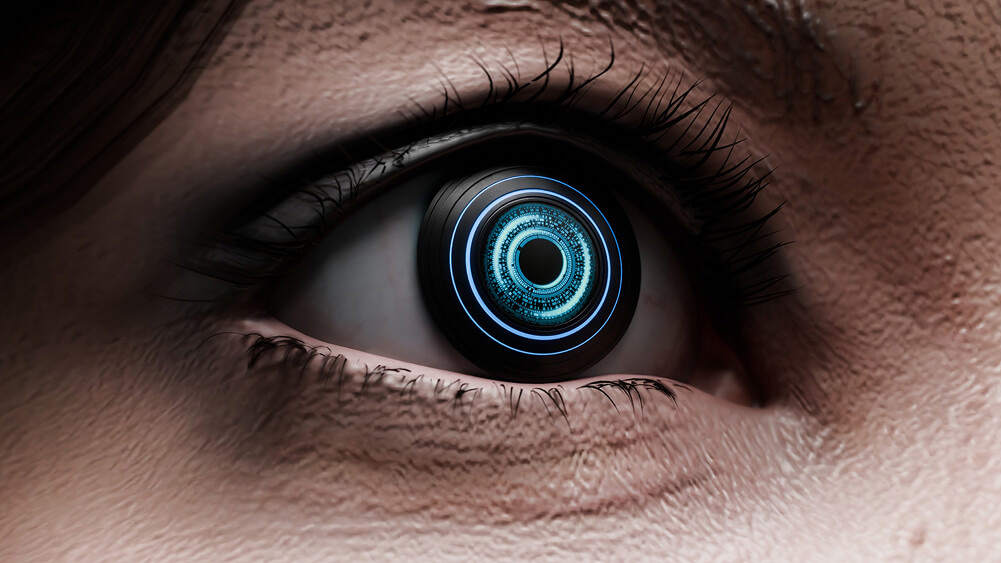
“Yes, at a party, the lenses could scan the room and instantly recognize faces, drawing on your personal contacts and social databases to remind you of people’s names, how you met, and important details about them before you even approach,” says Alexlrod, though he acknowledges that privacy concerns and regulations for such features are still far from being sorted out.
“The smart contact lens will act as the ultimate personal assistant embedded directly into your vision and capable of analyzing complex social environments in real-time.”
— Roman Axelrod, Xpanceo co-founder
You can also expect these next-gen devices to potentially improve our human capabilities, Inspector Gadget-style. For example, InWith CEO Michael Hayes predicts that smart contacts in 2035 will not only offer night vision but potentially even zoom capabilities.
“Seeing better in the dark is an advanced function, but we’ve already made significant progress. We can engineer lenses that enhance low-light vision. Nanoparticles alter the way the lens interacts with incoming light, effectively expanding what the eye can perceive in dim environments,” says Dr. Volkov.
“The idea of zooming in on distant objects is perhaps the most futuristic, but not impossible. This feature would require smart lenses with materials whose refractive properties can be dynamically controlled. Using electrical signals, the lens could adjust how it focuses light, effectively creating a variable ‘optical zoom’ function.”
“Although this technology is still in the research phase,” Volkov says, he also suspects that rapid progress in the field should mean working prototypes well before 2035.


Dan Bracaglia is the Tom’s Guide editorial lead for all things smartwatches, fitness trackers and outdoor gear. With 15 years of experience as a consumer technology journalist testing everything from Oura Rings to instant cameras, Dan is deeply passionate about helping readers save money and make informed purchasing decisions. In the past year alone, Dan has assessed major product releases from the likes of Apple, Garmin, Google, Samsung, Polar and many others.
An avid outdoor adventurer, Dan is based in the U.S. Pacific Northwest where he takes advantage of the beautiful surroundings every chance he gets. A lover of kayaking, hiking, swimming, biking, snowboarding and exploring, he also makes every effort to combine his day job with his passions. When not assessing the sleep tracking and heart rate accuracy of the latest tach gadgets, you can find him photographing Seattle’s vibrant underground music community.
You must confirm your public display name before commenting
Please logout and then login again, you will then be prompted to enter your display name.
